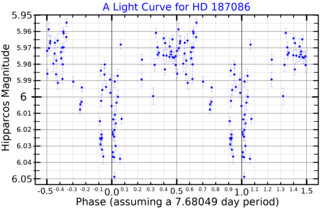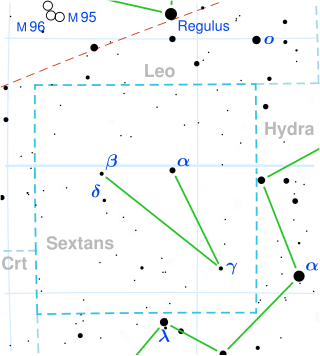
Omega Virginis is a solitary star in the zodiac constellation Virgo. It has an apparent visual magnitude of +5.2, which is bright enough to be faintly visible to the naked eye. Based upon an annual stellar parallax shift of 6.56 milliarcseconds, it is located about 500 light years from the Sun.

NO Apodis is a solitary, red hued variable star located in the southern circumpolar constellation Apus. It has an average apparent magnitude of 5.86, allowing it to be faintly seen with the naked eye. The object is relatively far at a distance of 790 light years but is drifting closer with a heliocentric radial velocity −18.3 km/s.

CQ Camelopardalis, abbreviated as CQ Cam, is a solitary variable star in the northern circumpolar constellation Camelopardalis. It has an apparent magnitude of 5.19, making it visible to the naked eye under ideal conditions. The object is relatively far at a distance of about 2,000 light years but is drifting closer with a heliocentric radial velocity of −22 km/s. It has a peculiar velocity of 21.8+2.1
−1.9 km/s, making it a runaway star.

HD 27245, also known as HR 1335 or rarely 25 H. Camelopardalis is a solitary red-hued star located in the northern circumpolar constellation Camelopardalis. It has an apparent magnitude of 5.4, making it faintly visible to the naked eye. Gaia DR3 Parallax measurements place it approximately 607 light years away from it the Solar System and is drifting further away with a heliocentric radial velocity of 25.2 km/s. At its current distance, HD 27245's brightness is diminished by 0.36 magnitudes due to extinction from interstellar dust. It has an absolute magnitude of −0.27.
HD 63399 is an orange hued star located in the southern constellation Puppis, the poop deck. It has an apparent magnitude of 6.45, placing it near the limit for naked eye visibility. Based on parallax measurements from Gaia DR3, the object is estimated to be 445 light years distant. It appears to be receding with a spectroscopic radial velocity of 28.5 km/s. At its current distance, HD 63399 is diminished by 0.29 magnitudes due to interstellar dust.

S Apodis, also known as HD 133444 is a variable star located in the southern circumpolar constellation Apus. It has an apparent magnitude ranging from 9.6 to 17, which is below the limit for naked eye visibility. The object is located relatively far at a distance of approximately 15,000 light years based on Gaia DR3 parallax measurements, but it is drifting closer with a heliocentric radial velocity of −75 km/s.
HD 30080, also known as HR 1509, is a solitary, orange hued star located in the southern constellation Caelum, the chisel. It has an apparent magnitude of 5.66, allowing it to be faintly visible to the naked eye. Parallax measurements from Gaia DR3 place the object at a distance of 612 light years. It appears to be approaching the Solar System with a heliocentric radial velocity of −3.8 km/s. Eggen (1989) lists it as a member of the thick disk population.

HD 174387 is a solitary star in the southern constellation Telescopium. With an apparent magnitude of 5.49, it is faintly visible to the naked eye if viewed under dark skies. Parallax measurements put the object at a distance of 810 light years and it is currently approaching the Solar System with a heliocentric radial velocity of −28.1 km/s.
HD 1032 is a solitary star in the southern circumpolar constellation Octans. It is faintly visible to the naked eye with an apparent magnitude of 5.77 and is estimated to be 850 light years away from the Solar System based on parallax measure. However, it is receding with a heliocentric radial velocity of 4 km/s.
HD 37289, also known as HR 1916, is a solitary, orange hued star located in the northern circumpolar constellation Camelopardalis. It has an apparent magnitude of 5.61, making it faintly visible to the naked eye under ideal conditions. Based on parallax measurements from the Gaia spacecraft, the object is estimated to be 308 light years distant. It appears to be approaching the Sun, having a heliocentric radial velocity of −20.7 km/s.

AF Columbae, also known as HD 42682, is a solitary, red hued variable star located in the southern constellation Columba, the dove. It has an apparent magnitude that fluctuates between 5.6 and 5.71. Nevertheless, it is faintly visible to the naked eye. Parallax measurements from the Gaia spacecraft place the star relatively far at a distance of 820 light years. However, it is approaching the Solar System with a poorly constrained radial velocity of −19 km/s.
HD 43899, also designated as HR 2263, is a solitary, orange hued star located in the southern constellation Columba, the dove. It has an apparent magnitude of 5.53, allowing it to be faintly visible to the naked eye. Based on parallax measurements from the Gaia spacecraft, the object is estimated to be 284 light years distant. It appears to be rapidly receding with a heliocentric radial velocity of 66.5 km/s. Eggen (1993) lists HD 43899 as an old disk star and its kinematics match with that of the ζ Herculis moving group.

23 Leonis Minoris is a solitary, bluish-white hued star located in the northern constellation Leo Minor. It is positioned 7° south and 11" west from β Leonis Minoris. It is rarely called 7 H. Leonis Minoris, which is its Hevelius designation.
28 Leonis Minoris is a solitary, orange hued star located in the northern constellation Leo Minor, the lesser lion. It has an apparent magnitude of 5.5, allowing it to be faintly visible to the naked eye. Based on parallax measurements from the Gaia satellite, it is estimated to be 480 light years distant. 28 LMi is approaching the Solar System with a heliocentric radial velocity of −24 km/s. At its current distance, the star brightness is diminished by 0.14 magnitudes due to interstellar dust.

HD 198716, also known as HR 7987 or 33 G. Microscopii, is a solitary star located in the southern constellation Microscopium. Eggen (1993) lists it as a member of the Milky Way's old disk population.

HD 117566, also known as HR 5091, is a solitary yellow-hued star located in the northern circumpolar constellation Camelopardalis. It has an apparent magnitude of 5.74, making it faintly visible to the naked eye. This object is relatively close at a distance of 291 light years based on Gaia DR3 parallax measurements but is receding with a heliocentric radial velocity of 14 km/s. At its current distance, HD 117566's brightness is diminished by 0.12 magnitudes due to interstellar dust.

HD 187086, also known as HR 7537, is a probable astrometric binary located in the southern constellation Telescopium. It has an average apparent magnitude of 5.9, making it faintly visible to the naked eye. The star is located relatively far at a distance of 1,020 light years based on Gaia DR3 parallax measurements but is rapidly drifting closer with a heliocentric radial velocity of −64 km/s. At its current distance, HD 187086's brightness is diminished by 0.27 magnitudes due to interstellar dust. It has an absolute magnitude of −0.8.

V718 Coronae Australis is a solitary variable star located in the southern constellation Corona Australis. It is faintly visible to the naked eye as a red-hued point of light with an apparent magnitude of 5.43. Gaia DR3 parallax measurements imply a distance of 630 light years and it is currently receding with a heliocentric radial velocity of 28.5 km/s. At its current distance V718 CrA's brightness is diminished by 0.37 magnitudes due to interstellar dust and it has an absolute magnitude of −1.03.

32 Leonis Minoris, also known as HD 90840, is a solitary star located in the northern constellation Leo Minor. It is faintly visible to the naked eye as a white-hued point of light with an apparent magnitude of 5.78. The object is located relatively far at a distance of 729 light-years based on Gaia DR3 parallax measurements and it is currently receding with a heliocentric radial velocity of 2 km/s, which is somewhat constrained. At its current distance, 32 LMi's brightness is diminished by 0.14 magnitudes due to interstellar extinction and it has an absolute magnitude of −1.02.

HD 85709 is a solitary star located in the equatorial constellation Sextans. It is faintly visible to the naked eye as a red-hued point of light with an apparent magnitude of 5.95. The object is located relatively far at a distance of 1,100 light-years based on Gaia DR3 parallax measurements but it is slowly drifting closer with a heliocentric radial velocity of −0.66 km/s. At its current distance, HD 85709's brightness is diminished with an interstellar extinction of two-tenths of a magnitude and it has an absolute magnitude of −1.30.













